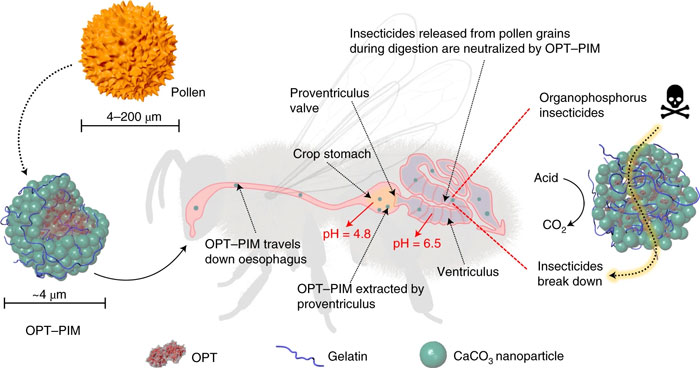Products You May Like
A heavily used group of pesticides, designed to kill insects upon contact, is also poisoning bee colonies.
Scientists have discovered a way to deliver an antidote using pollen-like microparticles. The medicine is composed of a special enzyme that can break down certain groups of insecticides called organophosphates.
These insecticides pose a deadly threat, but if the right enzymes go through the bees’ bodies under the right conditions, they could break down certain pesticides before they are digested and kill the bees.
When researchers tested their antidote – in this case, amidohydrolase phosphotriesterase, or OPT – on a small group of the common eastern bumblebee (Bombus impatiens), the rates of survival were stark.
In the lab, bumblebees fed pollen loaded with malathion – an organophosphate highly toxic to bees – died within four or five days. Meanwhile, those bees that received a meal of malathion and the OPT antidote delivered via the microparticle showed a survival rate of 100 percent.
Bees that received only the antidote without the microparticle protection had the same fate as those that only received the malathion meal.
The problem is, when bees eat toxic pollen grains, they are held in the gut for up to 12 hours, which makes them difficult to remove. This means the antidote must also get to the gut before digestion of these toxins occurs.
While OPT is effective at neutralizing organophosphates’ toxicity, it loses its stability – and thus its effectiveness – at high temperatures and low pH levels. Naturally, this describes a bee’s digestive environment.
To avoid being broken down in the bee’s acidic crop stomach, researchers encased OPT in protective microparticles made of calcium carbonate that are roughly the size of pollen grains and dubbed them PIMs, or pollen-inspired microparticles.
The PIMs protect the OPT past the crop stomach, allowing it to detoxify the pesticides in more amenable conditions.
 (Chen et al., Nature Food, 2021)
(Chen et al., Nature Food, 2021)
“We have a solution whereby beekeepers can feed their bees our microparticle products in pollen patties or in a sugar syrup, and it allows them to detoxify the hive of any pesticides that they might find,” explains biological and environmental engineer James Webb from Cornell University.
Webb, one of the co-authors of the study, is now the CEO of Beemmunity, a company using microparticles and their potential to save honey bee colonies. Two of this study’s authors are also shareholders in Beemmunity.
Today, pesticide residues are commonly found in bee honey, wax and pollen, and while no single chemical is responsible for the recent and catastrophic collapse in honey bees, it appears some organophosphates, like malathion, can put hives at substantial risk.
While this particular group of insecticides is widespread in agriculture, there are other toxins out there that bees are also harmed by.
Neonicotinoids are the most widely used class of insecticides worldwide, thought to endanger the life expectancy and the reproduction of honey bees.
To target more than just one group of pesticides, Beemmunity is filling its microparticles with a special absorptive oil. This would create a kind of sponge, sucking any neonicotinoids hiding in the bee’s gut up into the shell of the microparticle. The quarantined toxins can then later be pooped out by the bee.
Beemunity plans to test this spongy microparticle on 240 hives this summer.
Given how ubiquitous pesticides are and how long they can persist in the food chain, clearing the environment of these toxins will be incredibly difficult. Finding an antidote may be our best shot.
The study was published in Nature Food.
